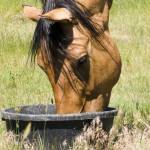Anemia in Horses: Supplemental Iron Not a Cure

Iron is the trace mineral most often associated with exercise, and many race trainers use some type of iron supplement. This assumed relevance stems from the well-known function of iron as part of the heme molecule, which gives blood its red color as well as its oxygen-carrying ability.
The first symptom associated with iron deficiency is anemia. The anemia associated with iron deficiency is hypochromic, microcytic anemia. There are few instances, however, when practical equine diets would result in iron deficiency anemia.
Unsupplemented horses rarely show signs of anemia, and even horses that have resting hematocrits below 34% (a blood parameter that defines anemia) do not usually respond to supplemental iron. A low hematocrit is more likely to be an indicator of infection, low-grade systemic disease, or marginal B-vitamin status.
Clinically significant anemia in the athletic horse is rare, though anemia is possible in severely parasitized horses, horses with gastric ulceration that leads to blood loss, and horses with severe exercise-induced pulmonary hemorrhage.
Mineral digestibility studies at Kentucky Equine Research failed to show any correlation between dietary iron intake and digestion of other minerals in diets with a wide range of iron content.








